REVIEW: The TLM instructional DVD by the FSSP. Stunning!
Get excited.
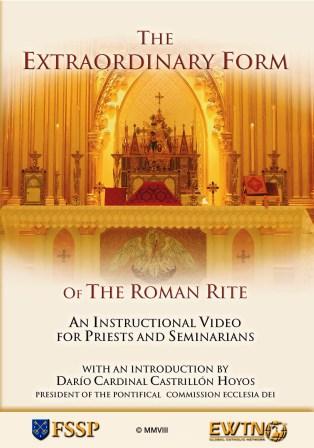 Mr. FedEx came today to present me with a package sent by the estimable Fr. Justin Nolan, FSSP, whom I interviewed for a PODCAzT.
Mr. FedEx came today to present me with a package sent by the estimable Fr. Justin Nolan, FSSP, whom I interviewed for a PODCAzT.
Fr. Nolan sent me an advance copy of their long-awaited instructional DVD for priests who desire to learn the older form of Mass.
The fuller title is The Extraordinary Form of the Roman Rite, an Instructional Video for Priests and Seminarians.
This DVD is stunning in its production values and its detail. It is easy to follow, well explained, beautifully recorded. This is a must obtain for priests, must give to seminarians, must be used by them set of disks.
I have been contending that Summorum Pontificum is primarily a gift for priests. Learning to say the older form of Mass changes a way a priest sees Mass and therefore sees himself. The flocks entrusted to the priests who come to this new understanding will in their own turn be affected. The DVD is therefore an essential tool in carrying out what I believe is Pope Benedict’s "Marshall Plan" for the Church, especially though a revitalization of her liturgical life.
The advance copy does not have the packaging or artwork but the content is identical to what will be released.
Many priests have already pre-ordered this DVD, which the FSSP is sending them for free. They still have a limited supply of free copies available to priests, first-come-first serve.
Special bulk order pricing is also available for dioceses and re-sellers. Contact Faye Trgovac at Fraternity Publications for more infromation: (570)842-4000 ext. 401 or email: publications@fssp.com
Shipping is to begin on 20 November to those who pre-registered. The DVD will be available for US$ 29.00.
There is a Spanish audio track along with English. They will make an international edition with French, German, Italian and Portuguese for the first quarter of next year. They are also making a version in Mandarin and Cantonese.
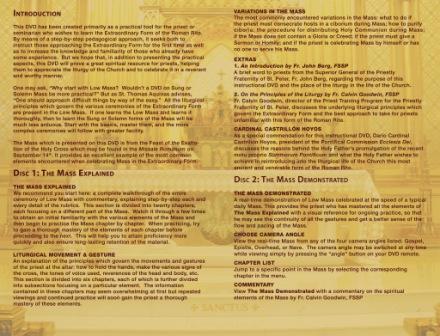 The term "Extraordinary Form" is used throughout.
The term "Extraordinary Form" is used throughout.
There are two disks. 1. The Mass Explained and 2. The Mass Demonstrated
There is an insert with the layout of the disk, et. all. Here is one page.
They also play on my computer in the DVD drive.
The Mass Explained is the meat and potatoes disk, while the Mass Demonstrated is the gravy.
The disks have interactive menus, with chapter lists so that you can navigate to what interests you.
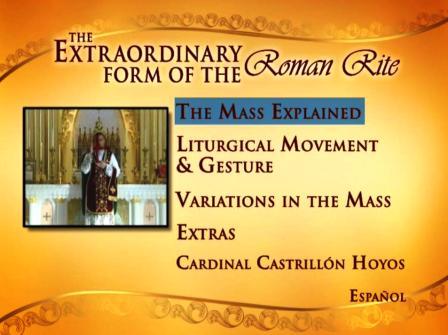
On The Mass Explained, there is a Mass which is explained in detail. But there is also another sector for how to make gestures, body postures, turns, bows, nods, etc. These are all clearly demonstrated.
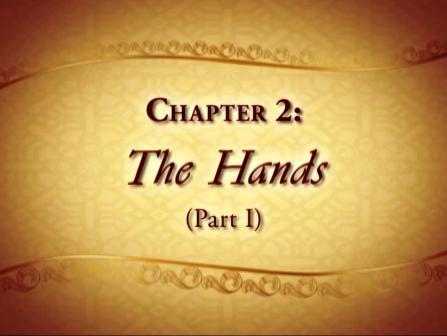
For the Mass itself, you see a Mass celebrated with running instructional commentary with ever changing camera angles.
The Mass Explained has the Low Mass appropriately for the Exaltation of the Cross (14 September), a day dear to us all. This Mass is useful, because the priest has a genuflection during the Epistle.
The instructions are both visual and oral. There seems to those in the know to be lots of extraneous detail but this pedantic detail will be welcome to priests and seminarians (bishops?) just starting out. Lay people could benefit from this as well.
There is an instruction to the priest to pray before Mass, using prayers in the Missal, before going to vest. This element reveals that the desire of the FSSP is to teach the priest to pray in a certain way when preparing to say Mass, in saying Mass, and also to give thanks afterward.
The DVD focuses not just on the priest, but also on the server. The vesting section shows the server how to lay vestments out for the priest. The vesting prayers are pronounced in Latin. I am not entirely satisfied with the clarity of the pronunciation and the volume drops compared to the narration of the instruction.
I was amused by a comment that the priest should have black shoes on. There is not mention of silver fibia or silver buckles! I guess a discalced Carmelite or other mendicant such as Franciscans were overlooked at this point, but I bet they will make the necessary adjustment. The same might be said about the biretta, talking about how the "middle fin" should be to the right. Not all liturgical birettas have only three points or fins. But this is not a big deal.
There are even demonstrations of how to fold a corporal. I am not kidding about the detail of the instruction.
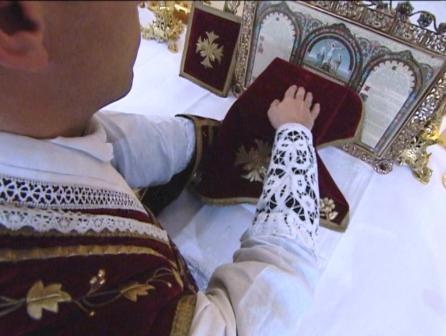
The server doesn’t kiss the hand/biretta at the beginning, but he attends to lifting the hem of the alb and cassock as he ascends.
I think some might quibble slightly with the way the priests turns, so as not to turn his back to the Blessed Sacrament.
There are many camera angles, which are very helpful. The transitions are good and smooth. I think they might use a little slow-motion to make sure you see what the priest does.
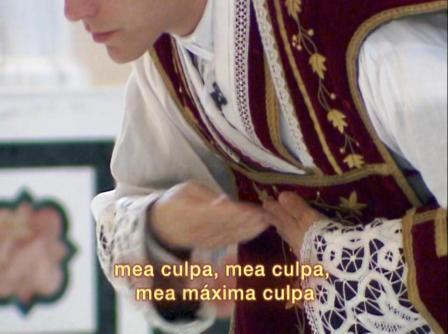
Text is flashed to accompany actions.
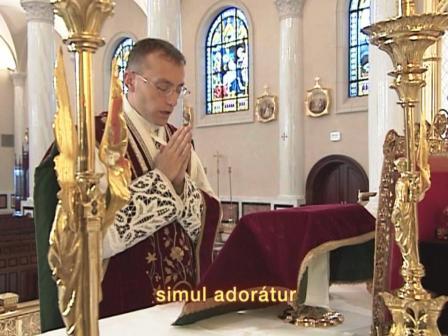
They also highlight some points that are going to be different from the Novus Ordo, such as the nine-fold Kyrie.
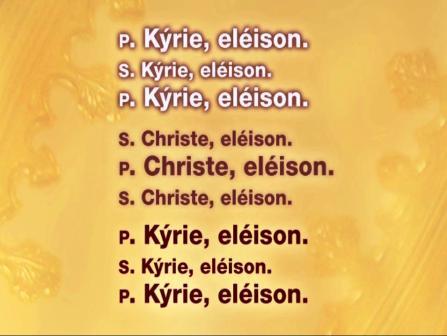
Animated graphics are used to show you the texts where actions are needed from the priest and then they show the priest doing what was explained. For example in the Gloria animated texts pop up to show when the priest bows his head. Very useful.
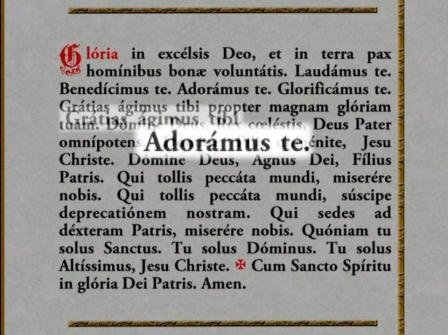
The video explains that the priest must memorize the conclusions for certain prayers.
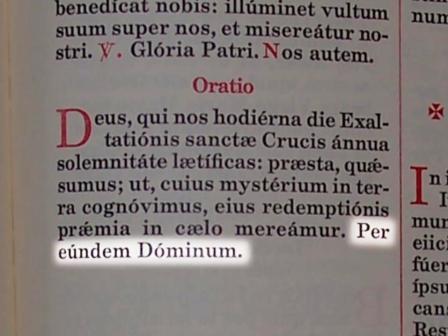
All along the way you are told when to speak loudly, or secretly, when you bow you head or bow your body and to what extent.
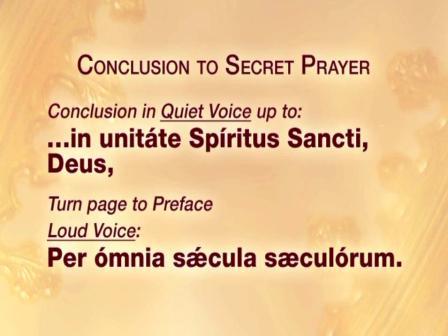
For the complicated moments, at least for beginners, such as the offertory and the actions before Communion, the DVD is invaluable. I think a newbie would be able to learn how to do everything well and smoothly from this DVD.

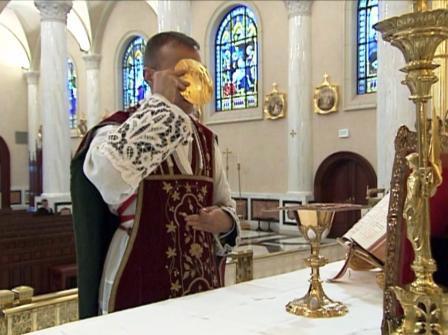
They show the priest back in the sacristry as well after Mass, blessing the server before the server then undresses the altar.
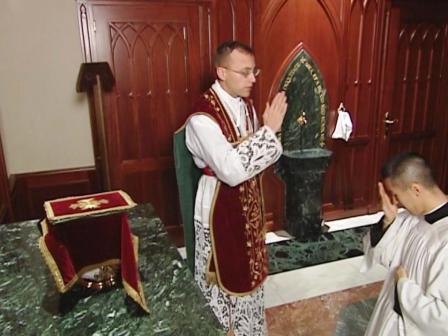
The "Variations in the Mass" section show you a Mass with a ciboria to be consecrated, where it should be placed, how to handle it, to cover and uncover, repose, and purify. You also see, as a variation, how to distribute Communion during Mass. you are instructed how to open the tabernacle, etc. There is no trace of the Second Confiteor. Of course the Second Confiteor is not in the 1962 Missale Romanum and that is what they are teaching. However, it might have been a good idea to show how to do this. The DVD explains Commemorations, which are a point of confusion for Mass. This is a rather extensive section. We are told about Masses with and without a Gloria and Creed. Preaching is covered.
Very useful is the Mass shown without a server, which a lot of men will want to know how to do, including variations in the texts to be prayed, as for example at the Confiteor and the response having nostri and nos. Where to put the water and wine, how to move the missal are all addressed.
On the second disk, The Mass Demonstrated might seem redundant at first, since the first disk was pretty detailed. What more could they do?
The Mass Demonstrated is simply a celebration of Mass without detailed instructional commentary in the default play. The many cameras are used appropriately in the default play. However, an added feature is that you can choose the camera angle you desire.
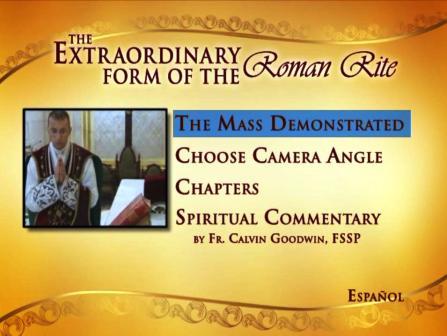
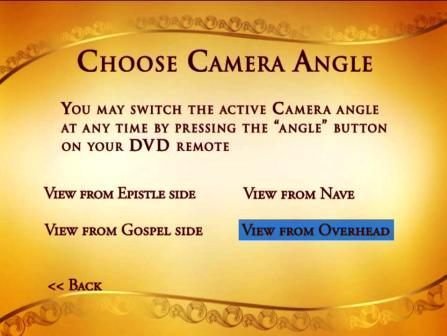
There is a slight glitch in the overhead angle when at the very beginning you catch the sandled foot of a camera guy, but, again, big deal. The ability to choose the camera angle could be very useful for the man trying to get a different view of some complex action: "How did he do that again?" – You can change your point of view so as to clarify questions.
The optional spiritual commentary by Fr. Goodwin, the priest in charge of the Training Program, is in a separate track you can choose, much as DVD’s of TV series or movies with have a director’s voice over. This commentary is directed especially for priests and seminarians. The commentary is tailored for the different moments of Mass, from the vesting to the return to the sacristy. It sounds like Fr. Goodwin has integrated also what Benedict XVI states in Sacramentum caritatis, especially about the priest getting out of the way so that the true action of the Mass can be clearer. As I listened to different parts of the Mass with the spiritual commentary, I found myself nodding my head, thinking that he got it just right. The comments also take a moment to underscore the meaning of a Communion Rail. There is a strong emphasis on silence, so lacking in so many churches. This is good, because that is a dimension of the older Low Mass which startles the newcomer and the newbie priest alike. Understanding the silence can help a nervous newbie priest, who has known nothing but the Novus Ordo in the usual noisy-jangly style of celebration, set aside the need to "talk" or "get busy".
Silence will be a constant theme of the comments. The commentary also draws in Scriptural references.
The style of celebration of the priest, the ars celebrandi is sober and careful without being precious, a fault of many traditional priests, in my opinion. This disk would be useful for the server, to learn what to do, though there is no shot of the credence table. With supplemental materials this lacuna can be easily filled.
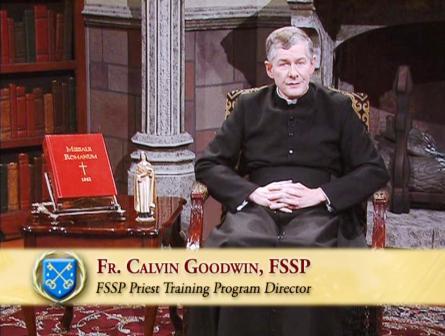
The Extras have a little talk by the Superior of the FSSP Fr. John Berg. There is also a talk by the priest in charge of the Training Program, Fr. Calvin Goodwin. He deals with some of the preconceptions and worries a priest might have about learning the older Mass. I like what he says about timidity and liturgical minimalism. He will leave Bishop Trautman unsatisfied when he says that "the ineffable is mediated by the sensible".
Fr. Goodwin talks about "conformity" and, something I have pounded at for years now, "receptivity". He clarifies that following rubrics is not mindless. Rather, even the external elements must not be undervalued. They must be a means for union with God. They mediate a deeper reality. Details matter. Conformity is also a means of freedom for true prayer. The priest must also be a good receiver of what he desire to pass on. Fr. Goodwin, when speaking of the receptivity of the faithful is exactly right. He explains well active receptivity.
Of course the DVD also has the now famous and long released video of His Eminence Dario Card. Castrillon Hoyos, President of the Pontifical Commission Ecclesia Dei.
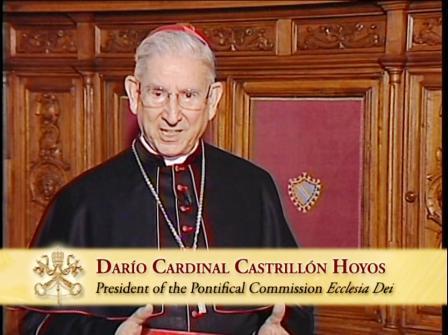
You will remember that His Eminence said about priests making the Extraordinary Form available:
Friends, get the DVD and use it. Learn this use of the Roman Rite, Reverend Fathers, and implement it in your parishes. You need not wait for requests.
Remember what Fr. Goodwin says in his presentation:
"The goals of the liturgy are not going to be advanced by clerical timidity or a liturgical minimalism. ... Fear does no good. What is needed is trust."
 Mr. FedEx came today to present me with a package sent by the estimable Fr. Justin Nolan, FSSP, whom I interviewed for a PODCAzT.
Mr. FedEx came today to present me with a package sent by the estimable Fr. Justin Nolan, FSSP, whom I interviewed for a PODCAzT. Fr. Nolan sent me an advance copy of their long-awaited instructional DVD for priests who desire to learn the older form of Mass.
The fuller title is The Extraordinary Form of the Roman Rite, an Instructional Video for Priests and Seminarians.
This DVD is stunning in its production values and its detail. It is easy to follow, well explained, beautifully recorded. This is a must obtain for priests, must give to seminarians, must be used by them set of disks.
I have been contending that Summorum Pontificum is primarily a gift for priests. Learning to say the older form of Mass changes a way a priest sees Mass and therefore sees himself. The flocks entrusted to the priests who come to this new understanding will in their own turn be affected. The DVD is therefore an essential tool in carrying out what I believe is Pope Benedict’s "Marshall Plan" for the Church, especially though a revitalization of her liturgical life.
The advance copy does not have the packaging or artwork but the content is identical to what will be released.
Many priests have already pre-ordered this DVD, which the FSSP is sending them for free. They still have a limited supply of free copies available to priests, first-come-first serve.
Special bulk order pricing is also available for dioceses and re-sellers. Contact Faye Trgovac at Fraternity Publications for more infromation: (570)842-4000 ext. 401 or email: publications@fssp.com
Shipping is to begin on 20 November to those who pre-registered. The DVD will be available for US$ 29.00.
There is a Spanish audio track along with English. They will make an international edition with French, German, Italian and Portuguese for the first quarter of next year. They are also making a version in Mandarin and Cantonese.
 The term "Extraordinary Form" is used throughout.
The term "Extraordinary Form" is used throughout.There are two disks. 1. The Mass Explained and 2. The Mass Demonstrated
There is an insert with the layout of the disk, et. all. Here is one page.
They also play on my computer in the DVD drive.
The Mass Explained is the meat and potatoes disk, while the Mass Demonstrated is the gravy.
The disks have interactive menus, with chapter lists so that you can navigate to what interests you.

On The Mass Explained, there is a Mass which is explained in detail. But there is also another sector for how to make gestures, body postures, turns, bows, nods, etc. These are all clearly demonstrated.

For the Mass itself, you see a Mass celebrated with running instructional commentary with ever changing camera angles.
The Mass Explained has the Low Mass appropriately for the Exaltation of the Cross (14 September), a day dear to us all. This Mass is useful, because the priest has a genuflection during the Epistle.
The instructions are both visual and oral. There seems to those in the know to be lots of extraneous detail but this pedantic detail will be welcome to priests and seminarians (bishops?) just starting out. Lay people could benefit from this as well.
There is an instruction to the priest to pray before Mass, using prayers in the Missal, before going to vest. This element reveals that the desire of the FSSP is to teach the priest to pray in a certain way when preparing to say Mass, in saying Mass, and also to give thanks afterward.
The DVD focuses not just on the priest, but also on the server. The vesting section shows the server how to lay vestments out for the priest. The vesting prayers are pronounced in Latin. I am not entirely satisfied with the clarity of the pronunciation and the volume drops compared to the narration of the instruction.
I was amused by a comment that the priest should have black shoes on. There is not mention of silver fibia or silver buckles! I guess a discalced Carmelite or other mendicant such as Franciscans were overlooked at this point, but I bet they will make the necessary adjustment. The same might be said about the biretta, talking about how the "middle fin" should be to the right. Not all liturgical birettas have only three points or fins. But this is not a big deal.
There are even demonstrations of how to fold a corporal. I am not kidding about the detail of the instruction.

The server doesn’t kiss the hand/biretta at the beginning, but he attends to lifting the hem of the alb and cassock as he ascends.
I think some might quibble slightly with the way the priests turns, so as not to turn his back to the Blessed Sacrament.
There are many camera angles, which are very helpful. The transitions are good and smooth. I think they might use a little slow-motion to make sure you see what the priest does.

Text is flashed to accompany actions.

They also highlight some points that are going to be different from the Novus Ordo, such as the nine-fold Kyrie.

Animated graphics are used to show you the texts where actions are needed from the priest and then they show the priest doing what was explained. For example in the Gloria animated texts pop up to show when the priest bows his head. Very useful.

The video explains that the priest must memorize the conclusions for certain prayers.

All along the way you are told when to speak loudly, or secretly, when you bow you head or bow your body and to what extent.

For the complicated moments, at least for beginners, such as the offertory and the actions before Communion, the DVD is invaluable. I think a newbie would be able to learn how to do everything well and smoothly from this DVD.


They show the priest back in the sacristry as well after Mass, blessing the server before the server then undresses the altar.

The "Variations in the Mass" section show you a Mass with a ciboria to be consecrated, where it should be placed, how to handle it, to cover and uncover, repose, and purify. You also see, as a variation, how to distribute Communion during Mass. you are instructed how to open the tabernacle, etc. There is no trace of the Second Confiteor. Of course the Second Confiteor is not in the 1962 Missale Romanum and that is what they are teaching. However, it might have been a good idea to show how to do this. The DVD explains Commemorations, which are a point of confusion for Mass. This is a rather extensive section. We are told about Masses with and without a Gloria and Creed. Preaching is covered.
Very useful is the Mass shown without a server, which a lot of men will want to know how to do, including variations in the texts to be prayed, as for example at the Confiteor and the response having nostri and nos. Where to put the water and wine, how to move the missal are all addressed.
On the second disk, The Mass Demonstrated might seem redundant at first, since the first disk was pretty detailed. What more could they do?
The Mass Demonstrated is simply a celebration of Mass without detailed instructional commentary in the default play. The many cameras are used appropriately in the default play. However, an added feature is that you can choose the camera angle you desire.


There is a slight glitch in the overhead angle when at the very beginning you catch the sandled foot of a camera guy, but, again, big deal. The ability to choose the camera angle could be very useful for the man trying to get a different view of some complex action: "How did he do that again?" – You can change your point of view so as to clarify questions.
The optional spiritual commentary by Fr. Goodwin, the priest in charge of the Training Program, is in a separate track you can choose, much as DVD’s of TV series or movies with have a director’s voice over. This commentary is directed especially for priests and seminarians. The commentary is tailored for the different moments of Mass, from the vesting to the return to the sacristy. It sounds like Fr. Goodwin has integrated also what Benedict XVI states in Sacramentum caritatis, especially about the priest getting out of the way so that the true action of the Mass can be clearer. As I listened to different parts of the Mass with the spiritual commentary, I found myself nodding my head, thinking that he got it just right. The comments also take a moment to underscore the meaning of a Communion Rail. There is a strong emphasis on silence, so lacking in so many churches. This is good, because that is a dimension of the older Low Mass which startles the newcomer and the newbie priest alike. Understanding the silence can help a nervous newbie priest, who has known nothing but the Novus Ordo in the usual noisy-jangly style of celebration, set aside the need to "talk" or "get busy".
Silence will be a constant theme of the comments. The commentary also draws in Scriptural references.
The style of celebration of the priest, the ars celebrandi is sober and careful without being precious, a fault of many traditional priests, in my opinion. This disk would be useful for the server, to learn what to do, though there is no shot of the credence table. With supplemental materials this lacuna can be easily filled.

The Extras have a little talk by the Superior of the FSSP Fr. John Berg. There is also a talk by the priest in charge of the Training Program, Fr. Calvin Goodwin. He deals with some of the preconceptions and worries a priest might have about learning the older Mass. I like what he says about timidity and liturgical minimalism. He will leave Bishop Trautman unsatisfied when he says that "the ineffable is mediated by the sensible".
Fr. Goodwin talks about "conformity" and, something I have pounded at for years now, "receptivity". He clarifies that following rubrics is not mindless. Rather, even the external elements must not be undervalued. They must be a means for union with God. They mediate a deeper reality. Details matter. Conformity is also a means of freedom for true prayer. The priest must also be a good receiver of what he desire to pass on. Fr. Goodwin, when speaking of the receptivity of the faithful is exactly right. He explains well active receptivity.
Of course the DVD also has the now famous and long released video of His Eminence Dario Card. Castrillon Hoyos, President of the Pontifical Commission Ecclesia Dei.

You will remember that His Eminence said about priests making the Extraordinary Form available:
"Even if it is not specifically asked for or requested, [priests] should make it available, so that everyone may have access to this treasure of the ancient liturgy of the Church. This is the primordial goal of the Motu Proprio [Summorum Pontificum]: a spiritual and theological richness."
Friends, get the DVD and use it. Learn this use of the Roman Rite, Reverend Fathers, and implement it in your parishes. You need not wait for requests.
Remember what Fr. Goodwin says in his presentation:
"The goals of the liturgy are not going to be advanced by clerical timidity or a liturgical minimalism. ... Fear does no good. What is needed is trust."

 inundado por um mistério de luz que é Deus e N´Ele vi e ouvi -A ponta da lança como chama que se desprende, toca o eixo da terra, – Ela estremece: montanhas, cidades, vilas e aldeias com os seus moradores são sepultados. - O mar, os rios e as nuvens saem dos seus limites, transbordam, inundam e arrastam consigo num redemoinho, moradias e gente em número que não se pode contar , é a purificação do mundo pelo pecado em que se mergulha. - O ódio, a ambição provocam a guerra destruidora! - Depois senti no palpitar acelerado do coração e no meu espírito o eco duma voz suave que dizia: – No tempo, uma só Fé, um só Batismo, uma só Igreja, Santa, Católica, Apostólica: - Na eternidade, o Céu!
inundado por um mistério de luz que é Deus e N´Ele vi e ouvi -A ponta da lança como chama que se desprende, toca o eixo da terra, – Ela estremece: montanhas, cidades, vilas e aldeias com os seus moradores são sepultados. - O mar, os rios e as nuvens saem dos seus limites, transbordam, inundam e arrastam consigo num redemoinho, moradias e gente em número que não se pode contar , é a purificação do mundo pelo pecado em que se mergulha. - O ódio, a ambição provocam a guerra destruidora! - Depois senti no palpitar acelerado do coração e no meu espírito o eco duma voz suave que dizia: – No tempo, uma só Fé, um só Batismo, uma só Igreja, Santa, Católica, Apostólica: - Na eternidade, o Céu!